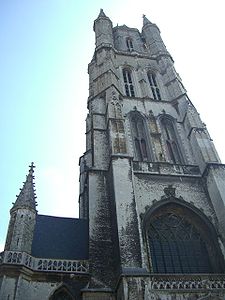
Jheronimus Vinders
Encyclopedia
Jheronimus Vinders (fl.
1525–1526) was a Franco-Flemish
composer of the Renaissance
, active at Ghent
. He was a minor member of the generation after Josquin des Prez
, and he also composed a notable lament on the more famous composer's death.
Next to nothing is known about his life, except that he was the singing-master at Onze-Lieve-Vrouwe-op-de-rade, the guild at St. Baaf cathedral
(formerly known as the Janskerk), in Ghent, in 1525 and 1526. That city was a prominent center of music-making throughout the Renaissance, and produced many famous composers and singers.
 Vinders' music has both progressive features, such as the pervasive imitation
Vinders' music has both progressive features, such as the pervasive imitation
which was to characterize the compositions of the generation of Gombert
and Clemens non Papa, and unusually conservative elements, such as use of the cantus-firmus technique, which had been old-fashioned since around 1500 or even before. Sometimes he combined both the conservative and progressive elements together in the same work, such as in his mass based on the famous tune Fors seulement, which uses both cantus-firmus
and parody
together (parody technique was to be the favorite method of mass composition right up to the end of the century; it used many voices of a multi-voice model).
Vinders wrote both sacred and secular music. All is polyphonic
music for voices; no instrumental compositions have survived, or been attributed to him. Four mass
es survive, all for five voices; all use different kinds of sources. The Missa Fors seulement is built on the chansons by Antoine de Févin
and Matthaeus Pipelare
; the Missa Fit porta Christi pervia is based on a plainchant cantus firmus; the Missa Myns liefkens bruyn ooghen uses as its source a secular song in Dutch, by Benedictus Appenzeller
; and the Missa Stabat mater uses the motet by Josquin, a composer he evidently admired. Eight of his motet
s survive, and they vary from four to seven voices; his famous O mors inevitabilis, a lament on the death of Josquin des Prez, is for seven. This is one of his most often recorded pieces in the present day, sometimes paired with Gombert's similar lament on Josquin's death, Musae Jovis; it has even been used as background music in a 2005 computer game, Civilization IV.
The three known secular songs by Vinders, "Myns liefkens bruyn ooghen", "Och rat van aventueren", and "O wrede fortune", are all in Dutch
, suggesting that this may have been his native language in bilingual Ghent; many of the composers from that area wrote French chanson
s, but if Vinders did, none have survived. The secular pieces are for four to six voices.
Floruit
Floruit , abbreviated fl. , is a Latin verb meaning "flourished", denoting the period of time during which something was active...
1525–1526) was a Franco-Flemish
Franco-Flemish School
In music, the Franco-Flemish School or more precisely the Netherlandish School refers, somewhat imprecisely, to the style of polyphonic vocal music composition in Europe in the 15th and 16th centuries, and to the composers who wrote it...
composer of the Renaissance
Renaissance music
Renaissance music is European music written during the Renaissance. Defining the beginning of the musical era is difficult, given that its defining characteristics were adopted only gradually; musicologists have placed its beginnings from as early as 1300 to as late as the 1470s.Literally meaning...
, active at Ghent
Ghent
Ghent is a city and a municipality located in the Flemish region of Belgium. It is the capital and biggest city of the East Flanders province. The city started as a settlement at the confluence of the Rivers Scheldt and Lys and in the Middle Ages became one of the largest and richest cities of...
. He was a minor member of the generation after Josquin des Prez
Josquin Des Prez
Josquin des Prez [Josquin Lebloitte dit Desprez] , often referred to simply as Josquin, was a Franco-Flemish composer of the Renaissance...
, and he also composed a notable lament on the more famous composer's death.
Next to nothing is known about his life, except that he was the singing-master at Onze-Lieve-Vrouwe-op-de-rade, the guild at St. Baaf cathedral
Saint Bavo Cathedral
thumb|right|225px|Sint-Baafs CathedralThe Saint Bavo Cathedral is the seat of the diocese of Ghent. It is named for Saint Bavo of Ghent....
(formerly known as the Janskerk), in Ghent, in 1525 and 1526. That city was a prominent center of music-making throughout the Renaissance, and produced many famous composers and singers.

Imitation (music)
In music, imitation is when a melody in a polyphonic texture is repeated shortly after its first appearance in a different voice, usually at a different pitch. The melody may vary through transposition, inversion, or otherwise, but retain its original character...
which was to characterize the compositions of the generation of Gombert
Nicolas Gombert
Nicolas Gombert was a Franco-Flemish composer of the Renaissance. He was one of the most famous and influential composers between Josquin des Prez and Palestrina, and best represents the fully developed, complex polyphonic style of this period in music history.-Life:Details of his early life are...
and Clemens non Papa, and unusually conservative elements, such as use of the cantus-firmus technique, which had been old-fashioned since around 1500 or even before. Sometimes he combined both the conservative and progressive elements together in the same work, such as in his mass based on the famous tune Fors seulement, which uses both cantus-firmus
Cyclic mass
In Renaissance music, the cyclic mass was a setting of the Ordinary of the Roman Catholic Mass, in which each of the movements – Kyrie, Gloria, Credo, Sanctus, and Agnus Dei – shared a common musical theme, commonly a cantus firmus, thus making it a unified whole...
and parody
Parody mass
A parody mass is a musical setting of the mass, typically from the 16th century, that uses multiple voices of another pre-existing piece of music, such as a fragment of a motet or a secular chanson, as part of its melodic material. It is distinguished from the two other most prominent types of...
together (parody technique was to be the favorite method of mass composition right up to the end of the century; it used many voices of a multi-voice model).
Vinders wrote both sacred and secular music. All is polyphonic
Polyphony
In music, polyphony is a texture consisting of two or more independent melodic voices, as opposed to music with just one voice or music with one dominant melodic voice accompanied by chords ....
music for voices; no instrumental compositions have survived, or been attributed to him. Four mass
Mass (music)
The Mass, a form of sacred musical composition, is a choral composition that sets the invariable portions of the Eucharistic liturgy to music...
es survive, all for five voices; all use different kinds of sources. The Missa Fors seulement is built on the chansons by Antoine de Févin
Antoine de Févin
Antoine de Févin was a French composer of the Renaissance. He was active at the same time as Josquin des Prez, and shares many traits with his more famous contemporary.-Life:...
and Matthaeus Pipelare
Matthaeus Pipelare
Matthaeus Pipelare was a Flemish composer, choir director, and possibly wind instrument player of the Renaissance.He was from Louvain, and spent part of his early life in Antwerp. Unlike many of his contemporaries, many of whom traveled to Italy, Spain or elsewhere, he seems never to have left...
; the Missa Fit porta Christi pervia is based on a plainchant cantus firmus; the Missa Myns liefkens bruyn ooghen uses as its source a secular song in Dutch, by Benedictus Appenzeller
Benedictus Appenzeller
Benedictus Appenzeller was a Franco-Flemish singer and composer of the Renaissance, active in Bruges and Brussels...
; and the Missa Stabat mater uses the motet by Josquin, a composer he evidently admired. Eight of his motet
Motet
In classical music, motet is a word that is applied to a number of highly varied choral musical compositions.-Etymology:The name comes either from the Latin movere, or a Latinized version of Old French mot, "word" or "verbal utterance." The Medieval Latin for "motet" is motectum, and the Italian...
s survive, and they vary from four to seven voices; his famous O mors inevitabilis, a lament on the death of Josquin des Prez, is for seven. This is one of his most often recorded pieces in the present day, sometimes paired with Gombert's similar lament on Josquin's death, Musae Jovis; it has even been used as background music in a 2005 computer game, Civilization IV.
The three known secular songs by Vinders, "Myns liefkens bruyn ooghen", "Och rat van aventueren", and "O wrede fortune", are all in Dutch
Dutch language
Dutch is a West Germanic language and the native language of the majority of the population of the Netherlands, Belgium, and Suriname, the three member states of the Dutch Language Union. Most speakers live in the European Union, where it is a first language for about 23 million and a second...
, suggesting that this may have been his native language in bilingual Ghent; many of the composers from that area wrote French chanson
Chanson
A chanson is in general any lyric-driven French song, usually polyphonic and secular. A singer specialising in chansons is known as a "chanteur" or "chanteuse" ; a collection of chansons, especially from the late Middle Ages and Renaissance, is also known as a chansonnier.-Chanson de geste:The...
s, but if Vinders did, none have survived. The secular pieces are for four to six voices.

